Form follows function, and what follows are bluefish and striped bass. Fishermen Scott Maccaferri, owner of On-Island Lures, and John Herman, owner of The Chappaquiddick Lure Company, share a love of working with wood, a passion for fishing, modest marketing goals, and a singular business philosophy that many Islanders appreciate: work should not take time away from fishing.
Their classic poppers, darters, swimmers, and needlefish – commonly referred to as plugs – appear to have been born from a cut broomstick and are designed to imitate struggling or swimming bait in one form or another. Their wood creations fill a small niche among rows of the newest high-tech hard and soft plastic lures manufactured in a wide variety of shapes, sizes, and finishes, many amazingly lifelike in color and appearance.
But if fishing were only about catching fish and saving money, fishermen would go to the fish market. Tradition and craftsmanship still count for something in Island tackle shops, where the feel and balance of wood has not lost its appeal.
In their respective home shops, the men follow an American tradition of innovative plug-making that began in the late nineteenth century and blossomed following World War II. Stan Gibbs and Robert “Bob” Pond, names synonymous with the fabled days of big stripers and early lure companies, developed many of their plugs casting into the Cape Cod Canal. The classic Gibbs Pencil Popper, made for distance, and Pond’s Striper ATOM swimmer with a metal lip, now made in plastic, still catch fish today.
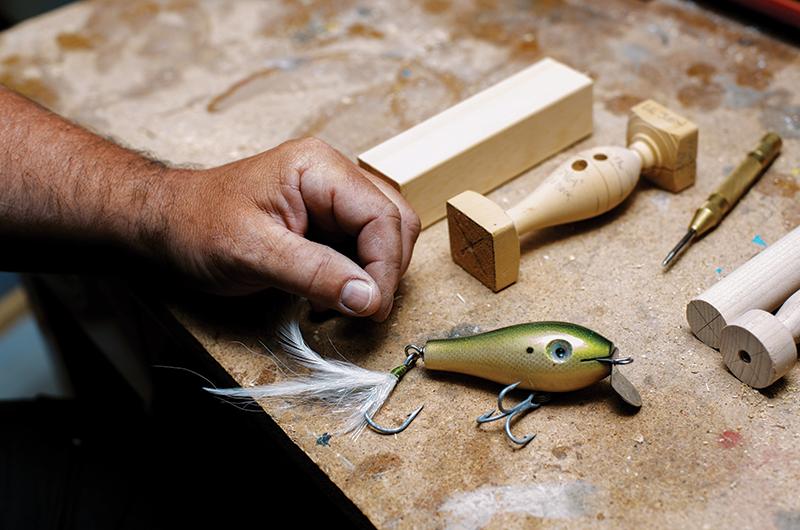
Nelson Bryant, outdoor columnist for The New York Times for nearly four decades, and a resident of West Tisbury until his death in January 2020, described that innovation in a column, “Lures Tell Fishing’s History,” published June 21, 1981. “It is difficult for today’s young angler to realize that there was a time when tackle shops festooned with lures weren’t ubiquitous, a time when an angler, not finding what he wanted, often manufactured his own. I recall, on the New England seacoast in the 1930s, when extremely effective trolling spoons for bluefish, mackerel and pollack were fashioned from the chrome rings that encircled the headlights of automobiles. They had just the right curve and flash.”
Throughout the nineteenth century and well into the twentieth century, fishermen used lures made of metal. They were known as tins, for the material used, and spoons because, in 1834, fisherman Julio T. Buel was in his canoe eating lunch on Lake Bomoseen in Vermont when he hit a rock and dropped a silver spoon into the water. He watched as a large fish grabbed the oscillating spoon. He raced home, took another spoon from his mother’s kitchen, cut off the handle, and added a hook. He returned to the lake, caught a big lake trout, and started a lure company. Buel Spinners are still sold today.
James Heddon of Dowagiac, Michigan, is credited with producing the first commercially made topwater wooden lure. Popular legend, according to the South Bend Tribune, is that Heddon was carving a stick along the banks of a local lake when he threw a sliver of wood into the water and a big freshwater bass surfaced and inhaled it. “That gave Heddon the idea to create a topwater lure because, at that time, nearly all fishing lures ran underwater.”
That story is generally considered to be more marketing fabrication than fact, but there is no doubt that the Dowagiac Casting Bait received a patent on April 1, 1902, and was immensely popular and profitable for the new lure company. The excitement of a surface strike fueled enthusiasm for bass fishing.
The newspaper reports that “Heddon, who was more interested in fishing than owning a business,” turned the work over to his son Charles, who built a lure manufacturing company that became one of the largest in the world.
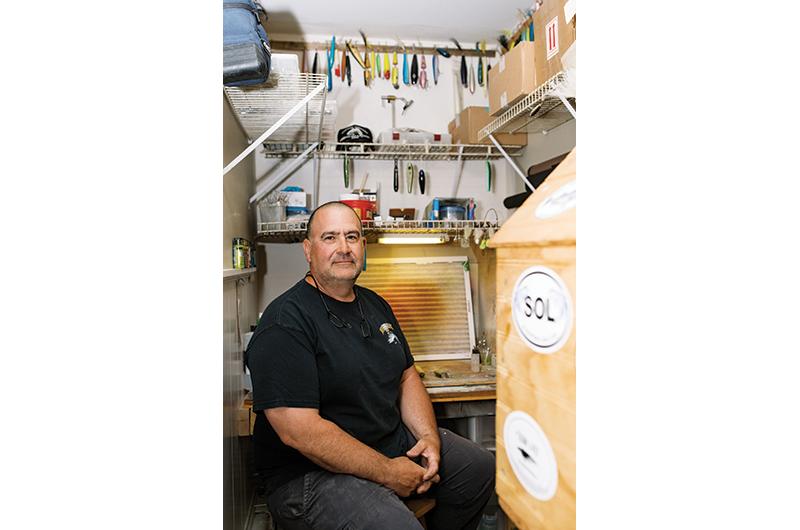
Maccaferri’s splash of inspiration came while he was serving in the Coast Guard and working in the Coast Guard Academy’s civil engineering lab in New London, Connecticut. Given the ready availability of broken broom handles, the cost of lures, and his access to tools, he thought, “Hey, I bet I could make my own lures.”
He, his wife, Madeline, and their three children arrived on the Vineyard in 2008 when he was transferred to Station Menemsha. His academy co-workers gave him a wood lathe as a going-away gift that proved very useful.
Maccaferri retired from active duty in January 2013 after twenty-one years of service and now works for the Coast Guard as a commercial fishing vessel safety examiner. He says the appeal of wood over plastic is in the material itself. “You’re more connected to that block of wood than a couple of chemicals mixed in a cup,” he says. “There’s just something about that block of wood – you can just shape it and do anything you want with it.”
Maccaferri works on plugs in the winter. On Memorial Day the one-man shop shuts down. When he’s not inspecting vessels, he goes fishing.
He uses Alaskan yellow cedar for his floating jointed swimmers and pencil poppers, and maple for needlefish. The spooks and the needlefish tend to be the most popular among his Vineyard customers.
He sticks to “tried and true” color patterns, mostly built around white.
“I don’t stray too far,” he says. Given all the choices, why do fishermen pay a premium for a handmade wooden lure?
“Fishermen appreciate craftsmanship,” he says. “It’s the same reason why some people buy a custom rod.”
His lures are available at Larry’s Tackle Shop and Coop’s Bait & Tackle in Edgartown, and at Mac’s, his wife’s barbershop located in a wing of their house off State Road in Vineyard Haven. He has no website. No Facebook promotion.
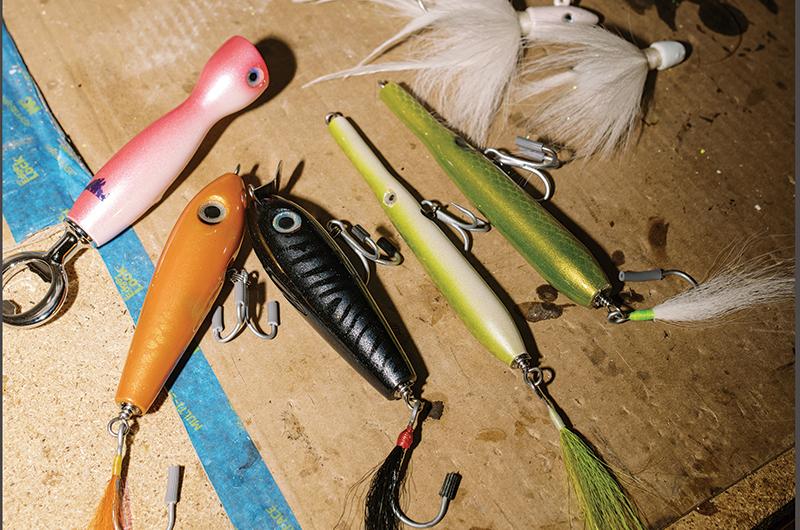
“I don’t want anything to do with that stuff,” he says. “I make a bunch of plugs. Guys fish them. And I make a couple of bucks to turn around and buy more supplies and maybe a beach sticker for my truck. And if someone sends me a picture with a fish they caught with one of my plugs, that’s really neat.”
The Chappaquiddick Lure Company, a.k.a. Chappy Lures, was born on the small island of the same name where Jonathan Herman, his wife, Morgan, and their two teenage sons, residents of Brookline, spend much of the summer. His wife’s family history on Chappy, where her mother Lindsay Allison lives, extends back several generations.
A native of Pittsfield, Massachusetts, Herman graduated from law school but decided the profession was not for him and he started a light construction and painting business. When he began to surf fish, he thought he could make lures.
“Which of course was an economically stupid idea,” he says with a laugh. “But it’s awesome to catch fish on your own lures.”
Despite possessing fine woodworking and painting skills, Herman says his learning curve was about ten years. “But now I finally feel like I know what I’m doing.”
A stay-at-home dad, his lures are available only at Larry’s, owned by friends and Chappy residents Peter and Melissa Sliwkowski. He can produce as many as 150 plugs each winter working in a small shop in his basement. He’s not interested in replicating the efficiency or drudgery of a production line. “I like the art side of it a bit more. If it’s going to take me a bunch of time for a lure, I want to spend even a little more time on it to make it how I want it to look.”
That attention to detail has earned him a following. Many of the people who buy his lures prefer to display them rather than cast them and risk subjecting the finish to a toothy bluefish.
He produces primarily darters, poppers, and needlefish from blocks of Alaskan yellow cedar. The process begins on a lathe and ends in a multi-stage process of painting and sealing the individual lures. Start to finish, and working in stages, a batch of lures could take one year to complete.
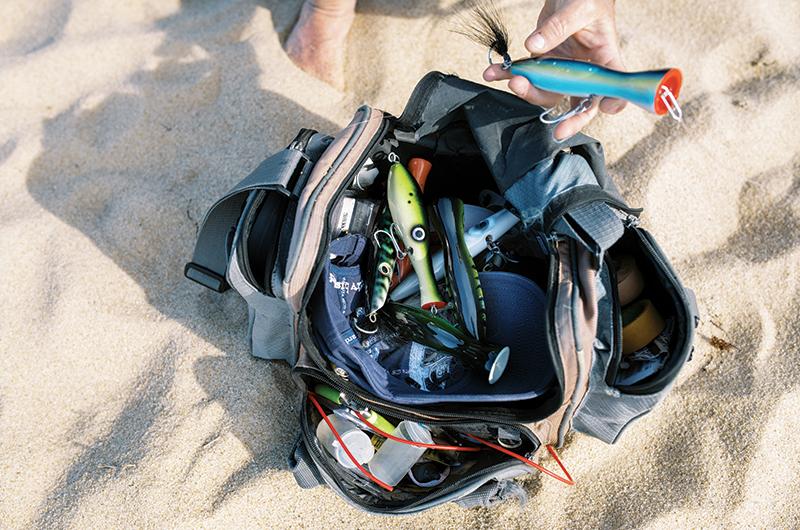
“The work keeps me thinking about fishing in the off-season,” he says.
And then there is the satisfaction of starting from nothing and coming up with a fishing lure that can be used or displayed.
He is a regular on Chappy, with its miles of beach accessible only by oversand vehicles, particularly during the annual Martha’s Vineyard Striped Bass & Bluefish Derby. “It’s kind of a community out there,” Herman says.
“The best thing I do with my lures is to give them away to my friends on the beach. They always love that.”
Herman says fishermen appreciate the romance of wooden plugs and their connection to fishing history. “Stan Gibbs and all those fishermen. A lot of people caught a lot of big fish on those plugs,” he says.
More than a century after Heddon whittled by the water, the distinct feel and personality of a handmade wooden lure sets it apart from its molded counterpart. Artist and legendary Island fisherman Kib Bramhall of West Tisbury understands the appeal.
“In 1953, I found a wooden ATOM in the mouth of a dead shark on South Beach,” he says. “It was the first plug that I owned, and I caught a striped bass on it a couple of weeks later. I still have that plug and occasionally cast it simply to enjoy its tantalizing action and the memories and history that it represents.”
Bramhall says he knew many of the early lure makers, including Bob Pond, Stan Gibbs, Jerry Sylvester (creator of the Flap Tail), Charley Murat (MurEel), and Harry Heinzerling (Creek Chub), all of whom made wonderful wooden plugs.
“I fished a lot of them and felt a personal connection to each lure that never could be matched by mass-produced plastic. Once, I was in Stan Gibbs’s workshop as he rigged a custom order of pencil poppers for me, and those remain my all-time favorites, not just because they produce tremendous surface strikes, but because they were made for me by my friend.”

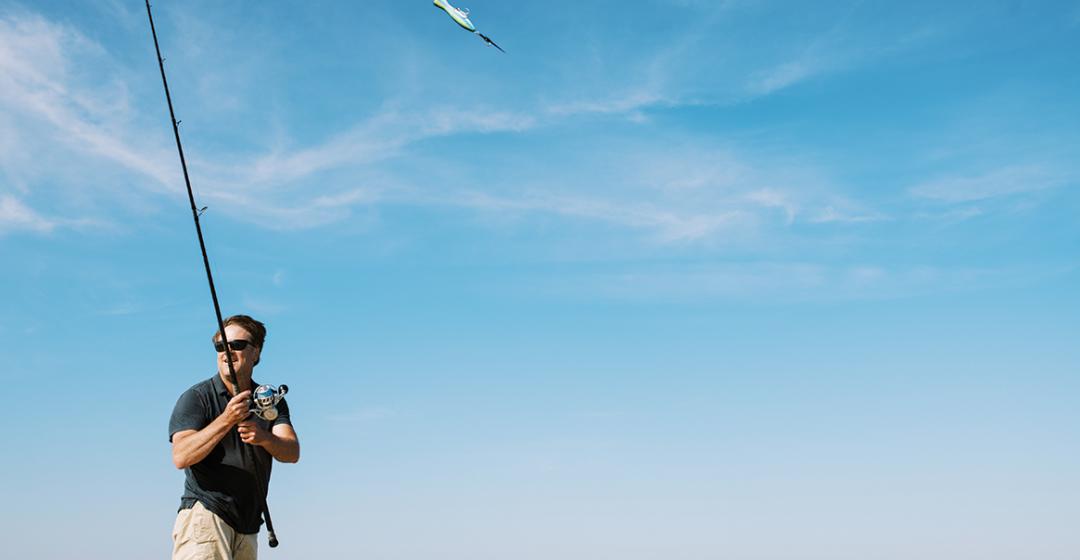


 1 comment
1 comment
Comments (1)